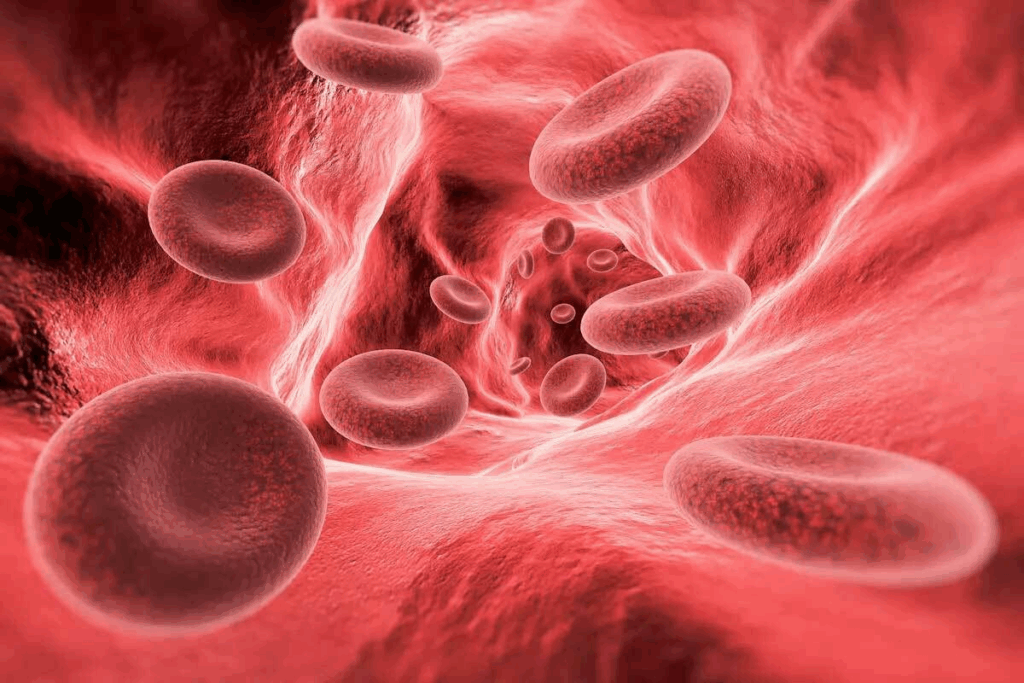Many people with chronic illnesses feel tired all the time. But they might be surprised to find out their iron levels are normal. At Liv Hospital, we know that anemia of chronic disease (ACD) is a condition where patients can be anemic even with normal iron levels.

ACD is a type of anemia that affects those with chronic conditions. This includes infections, autoimmune diseases, cancer, and chronic kidney disease. Knowing its symptoms and causes is key to good care.
We will look into the symptoms, how it works, and important facts about ACD. Our team at Liv Hospital is here to help with a patient-focused approach.
Anemia of Chronic Disease (ACD) is a complex condition linked to chronic inflammation. It’s also called anemia of inflammation.
Anemia Cronica, or Anemia of Chronic Disease, shows its chronic nature. It happens when chronic inflammation messes with red blood cell production. This leads to anemia.
Underlying Conditions That Cause ACD
Many chronic conditions can cause ACD, including:
These conditions cause chronic inflammation. This inflammation then affects how red blood cells are made.
| Underlying Condition | Effect on Red Blood Cell Production |
| Autoimmune Diseases | Inflammation disrupts erythropoiesis |
| Cancer | Tumor-related inflammation affects RBC production |
| Chronic Kidney Disease | Reduced erythropoietin production leads to anemia |
Anemia of chronic disease is puzzling. People can have anemia even with normal iron levels. This is due to the complex relationship between chronic inflammation and iron use.
In Anemia of Chronic Disease (ACD), the body’s iron use changes because of ongoing inflammation. Even with enough iron, the body can’t make red blood cells. This leads to anemia, even with normal or high iron levels.
The iron paradox in ACD is when there’s enough iron but it’s not used for hemoglobin. Chronic inflammation causes this by making cytokines. These disrupt how iron is used in the body.

Chronic inflammation changes how iron is used in the body:
Understanding these changes is key to diagnosing and treating ACD. It shows why looking at iron levels alone isn’t enough. We must also consider inflammation and its effects on making blood cells.
It’s important to know the symptoms of anemia of chronic disease (ACD) for the right diagnosis and treatment. We will look at the common signs of ACD and how they differ from other anemias, like iron deficiency anemia.
The symptoms of ACD can vary, but often include fatigue, weakness, and shortness of breath. These happen because the body’s tissues and organs don’t get enough oxygen. This is due to fewer red blood cells or hemoglobin.
Other symptoms may include:
It’s key to remember that these symptoms can also be signs of other conditions. This makes it hard to diagnose ACD.
The symptoms of ACD and iron deficiency anemia can seem similar, but there are differences. For example, people with ACD might not have the usual signs of iron deficiency, like brittle nails or a swollen tongue.
Also, ACD often shows low hemoglobin but normal iron levels in lab tests. This is important for choosing the right treatment.
We need to understand these differences when diagnosing and treating anemia. This ensures patients get the right care.
Inflammation is key in anemia of chronic disease. It affects how the body makes red blood cells, leading to anemia.
Yes, inflammation can lead to anemia. It messes with the body’s ability to make erythropoietin, a hormone needed for red blood cells. Also, chronic inflammation can make the body less responsive to erythropoietin, adding to anemia.
Cytokines, proteins from inflammation, disrupt erythropoiesis. They can lower erythropoietin production and directly stop red blood cell growth. This interaction between cytokines and erythropoiesis is a major reason for anemia in chronic diseases.
It’s important to understand how inflammation affects blood cell production. Knowing how cytokines affect erythropoiesis helps doctors find better treatments for anemia in chronic disease patients.
ACD lab results can be confusing, showing normal iron levels but low hemoglobin. Lab tests are key in diagnosing Anemia of Chronic Disease (ACD). We’ll look at three main findings that show up in ACD.
ACD is puzzling because it has low hemoglobin but normal iron. This happens because ACD isn’t caused by iron deficiency. Instead, it’s the body’s inflammation that messes with iron use.
Inflammation makes cytokines, which affect hepcidin. Hepcidin controls iron use. So, even with normal iron, the body can’t make enough red blood cells. This leads to low hemoglobin.
In ACD, you might see low red blood cell count and hemoglobin. But, it can vary based on the disease’s stage and severity.
The low red blood cell count comes from less erythropoiesis. Chronic inflammation hurts the bone marrow’s ability to make red blood cells. Hemoglobin might stay relatively normal due to the body’s efforts or the disease’s nature.
Ferritin levels are often high in ACD, showing inflammation. Ferritin is not just about iron storage. It also rises with inflammation.
High ferritin with anemia might seem odd. But in ACD, anemia isn’t from iron lack. It’s because the body can’t use the iron it has.
To understand ACD lab findings better, here’s a quick summary:
| Laboratory Parameter | Typical Finding in ACD | Explanation |
| Hemoglobin | Low | Due to impaired iron utilization and decreased erythropoiesis |
| Iron Levels | Normal | Iron stores are not depleted, but iron is not effectively used |
| Red Blood Cell Count | Low | Result of decreased erythropoiesis due to chronic inflammation |
| Ferritin | Normal or High | Ferritin is an acute-phase reactant that increases with inflammation |
Managing anemia of chronic disease needs a mix of treatments. We’ll look at how to tackle ACD’s symptoms and boost patients’ quality of life.
The first step is to tackle the cause of the inflammation. This might mean treating chronic diseases like rheumatoid arthritis or cancer. By controlling these conditions, we can lessen inflammation and help with anemia symptoms.
For more on ACD causes, check out the National Institute of Diabetes and Digestive and Kidney website.
There are also specific treatments for anemia of inflammation. These include:
It’s key to tailor treatments to each patient’s needs. Working with healthcare providers, patients with ACD can get the right care and see health improvements.
Managing anemia of chronic disease (ACD) needs a full plan. This plan tackles both the main issue and the anemia itself. We know it’s tough, but with the right help, people can get better and live better lives.
One important step is to treat the cause of the anemia. This might mean taking medicine, changing how you live, or other steps to fight inflammation and improve iron use. By tackling the main problem, symptoms can lessen, and health can improve.
People with ACD can also make lifestyle changes to help their anemia. This could be eating more iron or making other health-boosting changes. Knowing how anemia and inflammation are linked is key. It helps people manage their condition better and enjoy life more.
By teaming up with doctors and making smart choices, people can handle ACD well. We’re dedicated to top-notch healthcare and support for those with anemia of chronic disease.
Anemia of chronic disease (ACD) is a condition where people with long-term illnesses, like autoimmune diseases or cancer, have low red blood cells. This happens even when their iron levels are normal.
Yes, it’s possible to have anemia even with normal iron levels. This is often seen in anemia of chronic disease (ACD). Inflammation can mess with how the body uses iron.
Inflammation can change how the body uses iron. It makes the body hold onto iron in macrophages. This makes it hard for the body to make new red blood cells, even with enough iron.
Symptoms of ACD include feeling very tired, weak, and short of breath. These symptoms are different from those of iron deficiency anemia.
Cytokines, made during inflammation, can slow down the production of red blood cells. They do this by stopping the production of erythropoietin and affecting the bone marrow.
Key findings in ACD include low hemoglobin with normal iron levels. There’s also a low red blood cell count with normal hemoglobin. Ferritin levels are often normal or high, even with anemia.
Treating ACD involves managing the underlying cause of inflammation. It also includes using erythropoiesis-stimulating agents and iron supplements to help with anemia.
Yes, long-term inflammation can cause anemia. It does this by affecting how the body uses iron and by slowing down the making of red blood cells.
Erythropoiesis-stimulating agents help increase red blood cell production in ACD. This can improve symptoms of anemia.
Managing ACD means treating the underlying cause of inflammation. It also involves using medication for anemia and making lifestyle changes to improve health.
Best Practice BMJ: Anemia of chronic disease – Symptoms, diagnosis and treatment. BMJ Best Practice. https://bestpractice.bmj.com/topics/en-us/95
Have questions or need assistance? Our team is here to help you with appointments, services, or general inquiries.